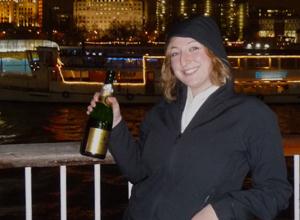
Midnight walk in Paris with Champagne in hand. Credit: Aefa Mulholland
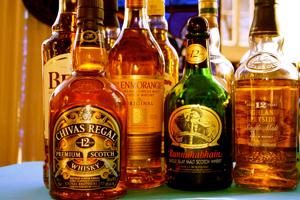
Scots welcome the New Year by downing a wee dram of Scotch whisky, "the water of life." Credit: Aefa Mulholland
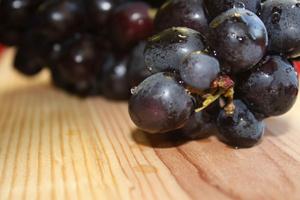
In Ecuador, people eat 12 grapes, one for good luck for each month of the new year. Credit: Aefa Mulholland
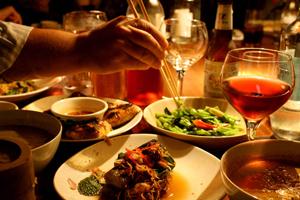
Bonenkai - or year-forgetting parties - held in Japan erase the old year from mind. Credit: Aefa Mulholland
Depending where you are, the arrival of the new year might be greeted by a lump of coal. Or a nice plate of boiled cod. Or a marzipan pig. Or a pair of yellow underpants. Or a water pistol fight. And these are just a few of the slew of surprising traditional components of some countries’ New Year celebrations.
While in Canada we usually stock up on crates of fireworks and champagne with which to welcome a new year, gays and lesbians in other places around the world have a marvellously motley array of local customs and unusual food and drinks poised to celebrate 2013.
• • •
Nytarsaftensdag, Denmark
What to do: It might not sound like the most festive of fish, but boiled cod is a New Year’s Eve must in Denmark. The Danes also stockpile a stash of broken dishes throughout the year and throw a stack of these celebratory ceramics on their friends’ doorsteps. The most popular people get to pick their way through pieces of plate to get out of their houses the next morning.
What to drink: Gløgg — hot red wine with vodka, cinnamon, cloves, raisins and slivers of almonds — and mead take pride of place on the Danish midwinter drinks menu.
• • •
Nochevieja, Spain
What to do: At each chime of the bells, Spaniards stuff a grape in their mouths. If they manage to down all 12 before the clock stops ringing — without requiring the Heimlich manoeuvre, they’re geared for good luck during the 12 months ahead. Those with travel plans grab a suitcase and take a turn around the block, to ensure good travel luck.
What to drink: Sparkling cava wine is the celebratory beverage of choice for Spaniards.
• • •
Réveillon de la Saint-Sylvestre, France
What to do: The French welcome in the new year with le réveillon de la Saint-Sylvestre, a midnight holiday feast featuring foie gras and other fine foods. While Paris sees a parade from the town of Chantilly to the Eiffel Tower, in some areas in the south of France, revellers troop along in a torchlight procession to local vineyards to toast the turn of the year with mulled wine.
What to drink: Champagne: when the French get festive, it has to be this fizz.
• • •
Hogmanay, Scotland
What to do: As bagpipes play in the streets, Scots “firstfoot” neighbours after “The Bells,” calling to neighbours’ houses with gifts of whisky, shortbread and lumps of coal. Shortbread acts as symbolic food for the household, coal is to keep the house warm, and, of course, whisky has its own distinct warming effect. Be warned, however; not everyone is guaranteed a welcome – Scots prefer tall, dark types as their firstfoot and may refuse admission to redhead visitors.
What to drink: Downing a wee dram of Scotch whisky, “the water of life,” is the way to welcome in the new year in Scotland.
• • •
Silvester, Germany
What to do: If you find yourself on the streets of Berlin on Silvester, you might assume that the main German new year tradition is to hurl fireworks indiscriminately into crowds, but elsewhere there are less pyromanic pursuits. Germans feast on silvesterkarpfen — baked carp — or on a “good luck pig,” which can be either the four-legged kind or simply piggy-shaped chocolate or marzipan. If you don’t eat pig or fish, don’t be tempted to substitute polutry or, the Germans believe, your luck and happiness will fly away with the bird’s feathers.
What to drink: Shout “guten rutsch!” (literally “good slide” into the new year) as you hoist a sparkling sekt wine, a steaming vat of spiced gluhwein or the flaming mulled wine and sugar punch known as feuerzangenbowle.
• • •
Año Viejo, Ecuador
What to do: Papier-mâché dummies, representing unwanted detritus, are a colourful way to get rid of enemies, exes, politicians and even problem family members. Stuffed with firecrackers, fireworks, vegetable matter, manure and bad memories, they’re set on fire at midnight. The foolhardy — or full of champagne — sometimes leap over the smouldering dummies, leading to far more painful memories for those unlucky enough to encounter a firework mid-leap.
What to drink: Champagne flows and, like many Spanish and Latin American countries, Ecuadorians accompany the turn of the year with12 grapes, each bringing a wish for each of the 12 months ahead.
• • •
Año Viejo, Venezuela
What to do: On the stroke of midnight, yellow undies are donned to change the wearer’s luck. Once resplendent in such suitably hued smalls, people write wishes in letters that are then burned and cart suitcases round their homes to precipitate travel.
What to drink: Champagne and grapes prevent Venezuelans hitting New Year hungry . . . or sober.
• • •
Festa de Iemanjá, Brazil
What to do: Brazilians leap over seven waves in order to bring love and honour in the year ahead. They also fling flowers, perfume, rice and other offerings at the departing waves so that Iemanjá, goddess of the sea, will grant them their wishes.
What to drink: Caipirinha cocktails and grapes provide celebratory sustenance. The next morning the boisterous Brazilians soak up the excesses with a hearty bowl of lentil soup, said to assure felicitous finances for the year ahead.
• • •
Oshogatsu, Japan
What to do: In Japan, bonenkai, year-forgetting parties, are planned to erase the old year from mind. As the year is cast into the past, the streets resound with the sound of 108 temple bells ringing, immediately followed by peals of laughter from Japanese revellers — intended to chase away any lingering bad spirits.
What to drink: Tuck into toshikoshi soba noodles, washing it down with otoso — sweet rice wine — and you’re guaranteed luck and a long life.
• • •
Songkran, Thailand
What to do: The Thais have a wet and wild way of welcoming each new year. They bring out buckets, hoses and water pistols and soak passersby, people in cars, people on bikes and people on trains during the splashy three-day celebration. Although Thais also mark Jan 1 and Chinese New Year, the biggest celebrations are reserved for Songkran, the traditional Thai New Year. Songkran is April 13, which, conveniently for this soaking celebration, falls during the hottest part of the year.
What to drink: A simple glass of water is the traditional accompaniment to this festival, but there are three particular treats associated with New Year menus: the peanut brittle-like tua that, a rice, nut and noodle treat called krayasad and a spicy soup known as pak jor.
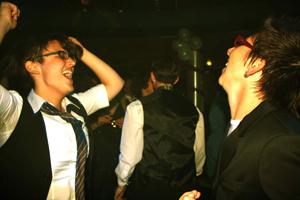
 Why you can trust Xtra
Why you can trust Xtra


